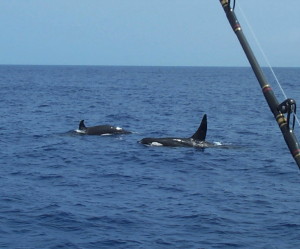From May, 2003 and reprinted in Kona Fishing Chronicles 2003/2004
Capt. Jeff Heintz was startled by the sight of huge explosions of white water “out in the middle of the porpoise school” and went to investigate. The pods of dolphin had turned frantic.
“We saw a massive school of porpoises going in 4 different directions,” Heintz said. “The big blasts of white water were odd, too. When porpoises are chasing flyingfish, they make a splash but these were much bigger eruptions. We understood when we got close. Two orcas came up next to our boat. My deckhand,Travis Bradford, is from Juneau, Alaska and identified them without question. They were totally white on the belly all the way up underneath the chin.

“One went up in the air next to the boat,” Heintz said. “Everything came out but the tail. It had blood dripping down its sides like it had just eaten a porpoise.”
Orcas feed on other marine mammals, with a special preference for seals and sea lions in colder climes. The few irregular visitors to Kona substitute dolphins, their closest relatives (“killer whales” are actually dolphins, as are all of the mammals commonly called “porpoises” here). Dolphins may be fast but orcas are even faster.
At that point, there were at least 6 orcas hunting among the “porpoise schools” off the coast, Heintz said. At the same time he saw 2 next to the Linda Sue II, Butch Chee reported seeing more. “Butch told me he saw 4 orcas right next to theHumdinger as they were chasing the porpoise school,” Heintz said.
On a subsequent trip, Heintz and Bradford may have discovered the unusual reason these rare critters have strayed from their normal hunting grounds to visit here. The Linda Sue II encountered an even rarer sight: a huge pod of sperm whales. Heintz was in 1,200-fathoms when he spotted spouts and came upon as many as 40 of the big marine mammals.
The spectacle of whales breaching and tail-slapping included a chilling sight: a pack of orcas was ominously tracking the pod of sperm whales. Orcas will cooperate to attack big whales, but Heintz thinks the whales may have been calving and the orcas were there to feed on the helpless newcomers. Linda Sue Sportfishing